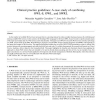Free Online Productivity Tools
i2Speak
i2Symbol
i2OCR
iTex2Img
iWeb2Print
iWeb2Shot
i2Type
iPdf2Split
iPdf2Merge
i2Bopomofo
i2Arabic
i2Style
i2Image
i2PDF
iLatex2Rtf
Sci2ools
KBS
2008
2008
Clinical practice guidelines: A case study of combining OWL-S, OWL, and SWRL
As the number of available Web services increases there is a growing demand to realise complex business processes by combining and reusing available Web services. In this context, the Ontology Web Language for Services (OWL-S) can be used to specify semantic types of the input and output data of a Web service and its functionality. This paper uses OWL-S to describe Web services and takes advantage of a XML syntax based on the OWL Web Ontology Language to encode OWL domain ontology fragments and SWRL rule fragments as the inputs and outputs of Web services. The approach presented outlines the use of the OWL's XML presentation syntax to obtain Web services that provide reasoning support and easily deal with facts and rules. To validate the proposal, the research has focused on Clinical Practice Guidelines (GLs) related to the biomedical field. This paper highlights the benefits and drawbacks found when applying the approach to obtain Web services that are intended to be used in cli...
| Added | 13 Dec 2010 |
| Updated | 13 Dec 2010 |
| Type | Journal |
| Year | 2008 |
| Where | KBS |
| Authors | Mercedes Argüello Casteleiro, Jose Julio Des Diz |
Comments (0)

